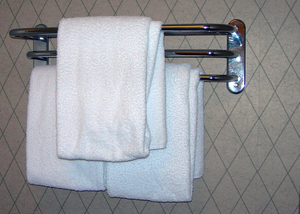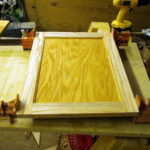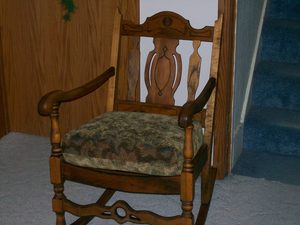Louvered closet doors are a good idea because they allow air to circulate in the closet, which discourages mildew and other pests. But repairing these doors when a slat gets broken and needs to be replaced can appear to be a huge job.
The carpenter’s recommendation would probably be to take the frame of the door apart and replace the slats, then reassemble and rehang the door. Faced with such a complex home repair job, many folks opt to just get a new door. But there are some quick tricks which will let you easily do an adequate job of replacing the slats. And you won’t have to remove the door.
The slats used for louvers in these doors are standard in size. You can buy wood this size – it’s called lattice strip, and it’s available at most home centers. These thin strips of wood can save you a lot of ripping with a power saw.
To replace the slats, first use a chisel to notch out the top of the broken slots on the back side of the door. Do this carefully so you don’t split the wood. Once the notches are cut, cut the lattice strip to the right length and slide the piece into the slots. When it’s in place, use a drill to put a small hole through the frame and then insert a brad (nail) to hold the replacement slat in place.
The next method is even easier than using wood lattice. Many home improvement stores carry a variety of trim made of polyurethane. This plastic molding is lightweight and easy to cut. Measure the width of the broken slat or remove it from the door and take it with you so you can be sure of getting molding of the correct width.
After removing the old louver, measure the length of the slats from the far end of one mortised slot to the far end of the other. Cut a piece of the plastic molding to this length and insert one end in one of the mortised slots. Bow the flexible plastic lattice strip and insert the other end. Then push the center in place, and the job is done for that slat. Repeat this procedure for as many slats as you need to replaced. If you can buy a color that is close to the color of your doors, you don’t even need to worry about painting.
Plastic molding is easy to work with, lightweight and inexpensive. But perhaps its most valuable quality is that the manufacturer can easily mold it into the intricate detail found in the plaster originals which grace many historical homes.
Some manufacturers of plastic moldings are making reproductions of some of the more popular plaster moldings used in old homes. Two areas where the art of the plaster worker are be shown at its most beautiful are crown molding and the ceiling medallion decorating the ceiling above the base of a chandelier.
Plastics work best in areas that aren’t subjected to hard use. They don’t respond well to bumps and knocks and are harder to patch than natural wood. So while plastic molding makes superb crown molding, don’t use it for chair railing. Another advantage to plastic trim is that it’s already colored. The selection of colors may not be the greatest, but it doesn’t need to be painted. And, of course, you can paint it your own chosen color, too.
There’s another good use for plastic trim.
The fit of vinyl flooring used in bathrooms is not always the best around tubs and cabinets. Even if the fit is close, over time the edge will begin to curl. This is especially true when moisture is present. Water splashed out of the tub or shower can get under the flooring and loosen the adhesive. A piece of plastic molding can be used to cover up these imperfections and makes a good-looking job. The plastic is not damaged by water and, as above, if the color is close to what you need, you don’t have to paint.
I don’t recommend the use of plastic moldings exclusively, but they can be put to good use on occasion. The closet-door louvers and bathroom trim are good examples of using alternate materials for specific applications where they will work well.
Pressed wood moldings are inexpensive. They are dense and therefore heavy. Pressed molding, like particle board, does not hold a nail well. The surface, often man-made, sometimes veneer, is delicate, and this makes the molding hard to work with. It does have its place, but it isn’t the material for fine finish work.
Solid wood molding is better for most projects and essential where the look of the wood will not be covered with paint. Hardwood molding is preferred because it does not scratch, chip and dent as softwood molding does.
When choosing molding, consider where it will be used and whether you are interested in a natural or painted finish. It would truly be a shame to use oak and then paint it. Plaster molding has for centuries been a distinctive trait of fine architectural finishing. Plaster molding is better than ever. New methods reinforce it with fiberglass, making it more durable. It is also very easy to repair.
Molding can do wonders for a room that is being remodeled. In older homes that have settled, cracks can appear where the ceiling and wall meet. A good choice of molding can camouflage these cracks and make the room more visually appealing.





